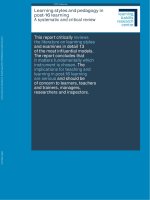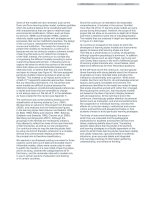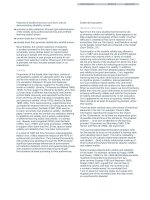DISCOVERING YOUR LEARNING STYLE
Bạn đang xem bản rút gọn của tài liệu. Xem và tải ngay bản đầy đủ của tài liệu tại đây (115.17 KB, 18 trang )
Discovering Your Learning Style
59
Secret 5
D
ISCOVERING
Y
OUR
L
EARNING
S
TYLE
N
ikia, Ann, Christy, Linda, and Colleen were more than
friends—they had known each other since nursery
school. Now, they were high school sophomores. Each
wanted to improve her grades, so Nikia, a natural leader,
suggested they form a study group.
The study group was a disaster. Linda only wanted to
tell stories. Christy, a born artist, gravitated toward pic-
tures, and Ann, who was most comfortable studying on
her own, hated all the arguments.
Colleen suggested they conduct an experiment: break
the material they were studying into pieces. Each person
would study and explain her piece of the material any
way she liked. It seemed like a crazy idea, so Linda liked
it immediately.
Gradually, the idea worked. The girls mixed their
learning styles. Nikia kept the group focused, and Ann
watched to make sure everyone had a chance to con-
tribute. The girls mixed their learning styles. Not every-
thing worked, however. Ann grew tired of Linda’s
crossword puzzles based on the names of Revolutionary
War generals. But Christy’s diagram of Bunker Hill
helped them all visualize the battle. Linda read aloud
from the diaries of soldiers. Colleen created a table
showing the men, materials, and casualties for each
Does the girls’ study group work? It would seem so. Or maybe only
when Nikia can keep such a gathering of diverse learners in focus! Did
you identify with anyone in the story?
Which learning styles do you use when studying? Learning
styles are different approaches to thinking and absorbing material.
We not only learn at different paces, but also in different ways.
Most of us have at least one dominant style, but all students use a
combination of learning styles—depending on the activity they are
involved in.
WHAT KIND OF LEARNER ARE YOU?
You are a unique learner: No one else processes information in
exactly the same way you do. When you discover the ways you learn
best, you can expand the strategies you use for learning and study-
ing. Ultimately, this will mean more efficient learning and test
taking.
Consider how you learn a new piece of information. For example,
when a friend gives you his or her phone number, how you do learn
and remember it?
Do you see the numbers in your head?
Do you say the numbers, perhaps over and over, in your head?
Do you say the numbers out loud?
Do you write the numbers in the air with your finger?
Do you make a picture of the numbers?
Do you hear the tones of the numbers?
Do you put the numbers in certain groupings?
Think about what you like to do and what comes easily to you. Usu-
ally you are comfortable doing certain activities, and you get more out
60
10 SECRETS TO ACING ANY HIGH SCHOOL TEST
side, and Nikia finally understood the cost of eighteenth-
century warfare.
Nikia drew several helpful diagrams, and shy Ann even
led two study group meetings. No one except Linda
wanted to create crossword puzzles based on generals’
names.
of these activities because they match your learning style. Do you
doodle? Do you love role-playing games? Are you a list maker? Are
you always active? These are clues to your learning style.
Let’s explore two major approaches to learning: Right-Brain/Left-
Brain and Gardner’s Multiple Intelligences.
Right-Brain, Left-Brain
One well-known approach to learning deals with whether the right
side or the left side of your brain is dominant. Modern scientists know
that your left brain is your verbal and rational brain, and your right
brain is your nonverbal and intuitive brain. You require special func-
tions from both sides of your brain to accomplish most tasks in your
daily life. However, there are some nonverbal tasks—such as drawing,
painting, dancing and music, at which your right brain excels and you
would be better off shelving your left brain functions to prevent inter-
ference from your rational side.
The two sides do communicate with each other, though, and you
will recognize aspects of your thinking process in both sides.
Although most people can be categorized as left- or right-brain
thinkers, there are exercises that can help you develop and nur-
ture either side. You can explore websites on the subject or even
take a free brain-dominance test at: brain.web-us.com/brain/
LRBrain.html.
Right-Brain Thinkers
Right-brain or creative thinkers (such as artists, composers, and
poets):
•
are usually left-handed
•
gather information by feelings and intuition
•
do not use a step-by-step process to gather information—rather, it
is visually gathered all at once
•
retain information by using images and patterns and are able to
visualize the whole idea
•
may seem illogical or disorganized because they are emotional,
intuitive, and abstract in their thinking
•
are good at coming up with innovative ideas
Discovering Your Learning Style
61
Left-Brain Thinkers
Left-brain or critical thinkers (such as scientists, accountants, and
lawyers):
•
are usually right-handed
•
are good at organizing
•
tend to be more orderly in their thought processes, collecting
information using logic and sense
•
retain information using words, numbers, and symbols
•
see only parts of the whole idea, which guide them in their logical,
step-by-step gathering of information
•
express themselves with concise words, numerical and written for-
mulas, and high-tech systems
Each kind of thinking has its own strengths. The right-brain thinker
will come up with a good theme for a birthday party, but the left-brain
thinker is the one you count on to organize the party, send out the
invitations, get the food, and find people to help decorate. The right-
brain thinker excels at creative games like charades, and the left-brain
thinker excels at games that require logic and following rules, like
chess. Right-brain thinkers like the rhythm of poetry. Left-brain
thinkers like figuring out the meaning of a poem. Are you left- or
right-brain dominant?
Tips from Damon for Right-Brain Thinkers
Damon, who studies with Amelia, relates what they study to what he
already knows, in very broad ways—often in ways that would not
occur to Amelia. Damon is what is called a global thinker.
When Damon is trying to understand a text, he uses imagery to
visualize the order of events. History class is a challenge for him. “All
those dates!” he cries. “They don’t make sense to me.” Imagining his-
torical events, Damon puts his mental pictures in order, like a car-
toon. Sometimes he draws them on paper. He then associated dates
with the pictures, using imagery to better understand the order of
events.
Damon is good at seeing the big picture, finding themes, and draw-
ing conclusions. He finds speaking his ideas into a tape recorder help-
ful. Sometimes, Damon uses his imagination to pretend that a
62
10 SECRETS TO ACING ANY HIGH SCHOOL TEST
textbook section is a speech or a play and he’s the announcer or actor.
He is often best able to express himself using art, music, or dance.
Tips from Amelia for Left-Brain Thinkers
Amelia is left-brain dominant; she naturally thinks in an orderly way.
This is called sequential thinking. She notes events and puts them in a
sequence to understand them. Amelia’s poetry class is a challenge—all
those images! So she turns her reading into a kind of detective story,
asking herself, “What happened first? Then what happened? What
next? What led up to the ending?” It is her sense of sequence that
allows her to create outlines of what happens in the poem and trans-
late them to images.
Amelia also rewrites her class notes in list or outline form, putting
details under major topic headings. She reads her notes into a tape
recorder and plays them back. She breaks her subjects into parts,
forming categories and subgroups. Timelines and formulas help her
remember data. Amelia takes advantage of her strong skills in deduc-
tive, rational, and concrete analysis.
Gardner’s Multiple Intelligences
Author Christopher Koch writes,
When Michael Jordan performs an inexplicable maneuver in the air above a
basketball court or Luciano Pavarotti extracts another shimmering high C
from the gristle of his vocal chords, we don’t necessarily think of either of
these men as being intelligent. They might be, but we assume these talents to
be peripheral to intelligence rather than proof of it.
Howard Gardner, a Harvard University professor of education and author,
disagrees. When Jordan lifts off or Pavarotti opens wide, Gardner sees intelli-
gence—something called bodily kinesthetic intelligence in the case of Jordan
and musical intelligence in that of the big tenor. Gardner doesn’t limit smarts
to the traditional realms of logical reasoning and the ability to manipulate
words and numbers. He says we are all endowed with eight distinct forms of
intelligence that are genetically determined but can be enhanced through
practice and learning.
—Christopher Koch, CIO Magazine, March 15, 1996
Dr. Gardner’s Multiple Intelligence (MI) Theory recognizes that
intelligence can come in many forms:
1. Verbal/Linguistic Intelligence—sensitivity to the meaning of
words, grammar rules, and the function of language, as in writing
Discovering Your Learning Style
63
an essay; someone with this kind of intelligence likes to “play
with words.”
2. Logical/Mathematical Intelligence—ability to see relationships
between objects and to solve problems, as in calculus and engi-
neering; someone with this kind of intelligence likes to “play with
questions.”
3. Visual/Spatial Intelligence—ability to perceive and mimic
objects in different forms or contexts, as in miming or impression-
ist painting; someone with this kind of intelligence likes to “play
with pictures.”
4. Musical/Rhythmic Intelligence—ability to hear tones, rhythms,
musical patterns, pitch, and timbre, as in composing a rap or a
symphony; someone with this kind of intelligence likes to “play
with music.”
5. Body/Kinesthetic Intelligence—loving movement, using the
body and motor systems in the brain to solve a problem, as in
catching a ball; someone with this kind of intelligence likes to
“play with moving.”
6. Interpersonal Intelligence—sensitivity to the actions, moods,
and feelings of others, as in teaching, parenting, politicking;
someone with this kind of intelligence likes to “play with social-
izing.”
7. Intrapersonal Intelligence—ability to understand and define
inner feelings, as in poetry and therapy; someone with this kind of
intelligence likes to “play alone.”
8. Naturalist Intelligence—sensitivity to animals, plants, and the
environment, noticing patterns in nature and caring deeply about
nature, as in collecting rocks and minerals; someone with this kind
of intelligence likes to “play in nature.”
STUDY AEROBICS
Integrating Technology into Multiple Intelligences
Yes, your learning style can be enhanced with technology.
64
10 SECRETS TO ACING ANY HIGH SCHOOL TEST
Discovering Your Learning Style
65
Verbal/Linguistic
•
e-mail and chat rooms
•
CD-ROMs and software teaching language, writing, editing,
and rewriting skills
•
desktop publishing programs and multimedia authoring
•
programs that allow you to create stories, poems, and essays
•
using tape recorders
•
browsing the Internet
Logical/Mathematical
•
computer programs and games that teach logic and critical
thinking skills
•
database and spreadsheet programs to organize data
•
problem-solving and math software or websites
•
Computer Aided Design (CAD) programs
•
strategy game software
•
graphing calculators
Visual/Spatial
•
draw, paint, and 3-D programs
•
surfing the Internet
•
organizing files and folders to develop spatial understanding
•
webpage design
•
software games
•
spreadsheet programs that allow you to see charts, maps, or diagrams
•
multimedia authoring programs
Music/Rhythmic
•
music composing software
•
CD, CD-ROM, and DVD players
•
programs integrating stories with songs and instruments
•
CD-ROMs about music and instruments
•
tape recorders
•
word processors (to write reviews or lyrics)









